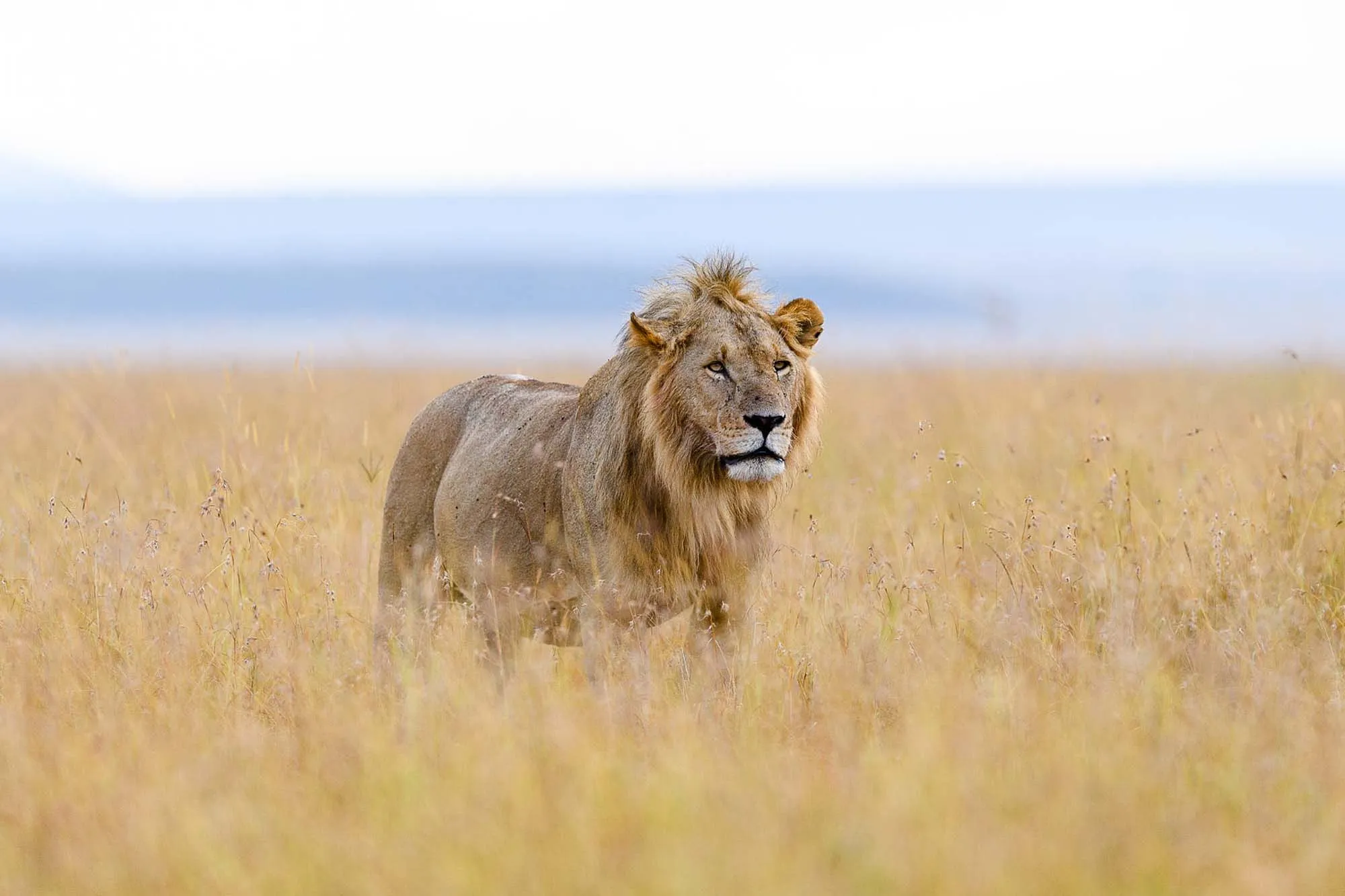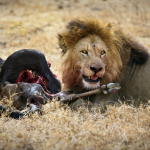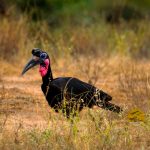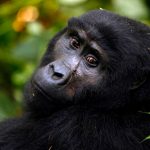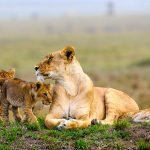The Majestic African Lion: King of the Savannah
It is said that the African Lion (Panthera leo) is more suited to its common title of “King of the Jungle.” It is considered one of the most iconic beasts on the African continent. With its impressive mane, graceful demeanor, and loud roar, it holds a remarkable position in African wildlife and human imagination and folklore. This big cat is one of the most amazing creatures, which attracts every traveler, conservationist, and enthusiast of the savannas of Africa with its power and grace. In this article, we look at everything remarkable about the African lion, from its habitat to social dynamics, the challenges it faces, and the conservation efforts afoot in protection.
Physical Description of the African Lion.
The African lion is a powerful, muscular big cat with a distinctive golden-brown coat to help it blend into the savanna landscape. Males are recognized by their stately manes-light blonde to dark black-growing out fuller and darker with age as a sign of dominance. Males are considerably larger than females, reaching a shoulder height of about 4 feet (1.2 meters) and weighing up to 550 pounds (150-250 kilograms).
For their part, females are smaller, with average weights varying between 260 and 400 pounds (120-180 kilograms). Their bodies, long and muscular in both sexes, have their tail terminate into that peculiar dark tuft, which helps them in pride membership communication. The large paws and retractable claws, strong jaws, and pointed canine teeth are all adapted for grasping and bringing down prey. Their eyes have an intense golden or amber color, affording them great eyesight essential for hunting, especially at twilight hours of the day.
Habitat and Distribution of the African Lion.
African lions are primarily found inhabiting grasslands, savannas, and open woodlands throughout sub-Saharan Africa. Once, their range did cover much of Africa, the Middle East, and even parts of Asia and Europe. Nowadays, lions are primarily to be found in Africa, with a few small populations in India’s Gir Forest. In Africa, the largest number of lions may be found in various reserves and National Parks, such as the Serengeti in Tanzania, Queen Elizabeth National Park of Uganda, Kenya’s Maasai Mara, and the Kruger National Park in South Africa.
Unlike other large cats, lions do not generally inhabit dense forests or deserts but open grasslands where their natural prey, like zebras, antelopes, and buffalo, is abundant. This provides them with an ideal setting to express their unique social behaviors and effect hunting besides rearing their prides.
Social Structure and Behavior of the African Lion.
Among big cats, Lions are the only social ones. They have what is termed a pride that typically consists of three males, several females usually related to one another, and their cubs. Each pride has a strict hierarchy, with males doing most of the defending of the territory and females in charge of hunting. The social structure will add to their rate of survival, strengthening bonds among members of the pride.

Male Coalition and Defence of Pride.
Males are characteristically recognised by their thick manes and are usually found in coalitions, comprising brothers or close kin. Such coalitions defend the pride against outside males and mark the territory with loud roars and scent marking. The role of male lions is also crucial in terms of cub defence of the pride. Indeed, in pride takeover events, the new males may kill the cubs to return females to heat, so they can sire their offspring. It is brutal but a natural adaptation to ensure that his line survives.
Cooperation of Female and Hunting.
The females are the main hunters of the pride and hunt together, taking down big animals like wildebeests, buffaloes, and zebras. The hunting behavior of the lions is just breathtaking; the animals share their strength, patience, and coordination in this cooperative undertaking. They usually stalk a target, remaining as secret as possible, after which they reach a striking distance of around 20 meters from which they launch their fast and forceful attack. A social cooperation like this makes lions different from most other big cats, solitary ones, such as leopards and cheetahs.
Diet and Hunting Technique of the African Lion .
Lions are apex predators, meaning they are at the top of the food chain. They eat majorly herbivores but scavenge on occasions when there is a need to do so. Their hunting technique is highly tactical, making use of coordination and teamwork between individuals. The lioness does most of the hunting, using her agility and speed to get near the prey before launching an attack.
Everything depends on the habitat where the lion lives. In the savanna, it can get a wide variety of prey that lions feed on, ranging from big animals like buffalo and giraffes to smaller game such as warthogs and impalas. On an average day, a lion consumes about 7 kgs of meat, about 15 pounds; however, upon a big kill, lions can eat as many as 30 kgs- 66 pounds at one time to save food energy for days when the need is low.
Life Cycle and Reproduction.
Sexual maturity is attained in 2-4-year-old lions. Following estrus a female lion will often copulate with many males in her pride, leading to extremely high cub survival rates due to protection by several males. Gestation is approximately 110 days; lionesses have litters of 2-4 cubs that are carefully hidden from the rest of the pride for a number of weeks.
Cub relocation is dependent on mothers for the first months of life, suckling milk, and staying vulnerable to threats from outside males, predators, even to starvation. At around two years of age, the male lions would have to leave the natal pride to establish or join new prides while females usually remain and continue with the family line, adding in the pride social bonds.
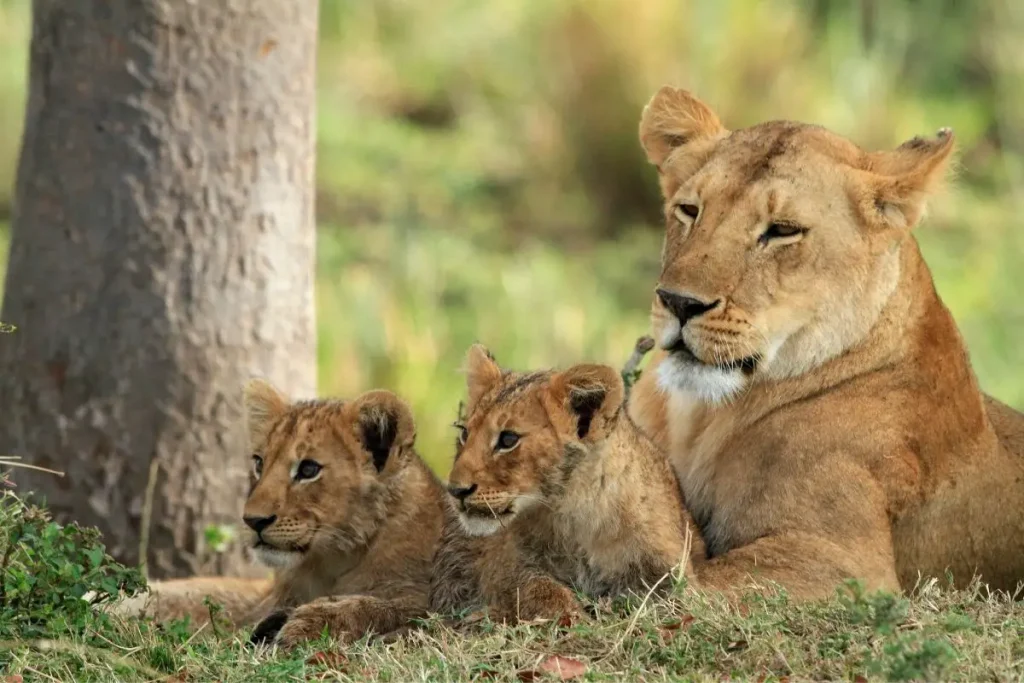
Life Span of the African Lion.
The life span of the African Lion is various between those that remain in the wild and those that are in captivity. Those in the wild have a life spanning 10 to 14 years since these have to go through ordeals such as fights over territories, lack of enough food, or threats from other predatory animals. Males do not seem to live as long as they are the ones at risk anytime it comes to pride and territorial defense. But in captivity, there are no uncommon sights of them reaching 20s and even 25 years of age, as captive lions receive regular nutrition, good healthcare, and protection from the predators that naturally affect their life expectancy.
The Roar and Communication.
The lion’s roar is one of the loudest calls within the animal kingdom and can be clearly heard for distances up to 8 kilometers. The call has multiple functions: it marks their territory, communicates to the members of their pride, and even serves to intimidate other coalitions. Each pride has its unique call-that functions just like a social identifier, enabling lions to recognize one another even over long distances.
In addition to roaring, communication in lions includes a range of body language, facial expressions, and scent marking. These skills provide them with a rich toolkit for maintaining social order in the pride and defending the boundaries from intruders.
Conservation Status and Threats.
At the moment, the African lion has been included in the IUCN Red List as Vulnerable, while the species are facing a decline due to habitat loss, human-wildlife conflict, and poaching. During the past century, the number of lions drastically fell; today, less than 25,000 lions are estimated to be roaming freely within the African wilderness. Their so-called sanctuaries are the protected areas of national parks and wildlife reserves, but even then, a large proportion of these animals face other challenges such as poaching and human encroachment.
The increasing demand for lion bones in the illicit wildlife trade, where bones are sometimes used as a substitute for those of tigers in traditional medicine markets, also complicates lion conservation. Besides, trophy hunting also has sparked serious controversy with its proponents claiming it raises funds for conservation and critics pointing out it is responsible for the decline in the lion population.
Conservation Efforts and How You Can Help.
The conservation for the African lion is already in good gear: through the efforts of organizations such as Panthera and Lion Guardians, and local governments, population monitoring takes place, establishment of corridors to ensure safe movement and a reduction in human-lion conflicts are expected. These various programs require community involvement for education on how to live safely with lions and sustainable land use.
Travelers and animal lovers do much in the conservation of lions by supporting eco-tourism, responsibly choosing safari operators, and providing donations to organizations for the same cause. Tourism dollars are a powerful incentive for local governments and communities to invest in lion protection, making the presence of these magnificent animals a source of pride and sustainable income.

Our Remarkable Packages to See Lions in Africa.
22 Days Best of Uganda Wilderness Adventure
18 Day Exploring Uganda Safari
14 Days Uganda and Kenya Wildlife Safari
14 Day Uganda-Rwanda Wildlife and Primates Safari
10 Day Highlights of Uganda Safari
9 Day Kenya Wild Safari Adventure
8 Day Gorillas-Chimps and Big Five Experience
8 Day Best of Tanzania Wildlife Safari
7 Day Kenya Wildlife Safari Tour
6 Day Gorilla Trekking and Queen Elizabeth
5 Day Serengeti and Lake Manyara Safari
5 Day Maasai Mara and Lake Nakuru Safari
4 Day Tanzania Wildlife Safari
3 Day Best of Akagera National Park
3 Day Ngorongoro Magical Adventure
Remarks on African Lion (Panthera leo).
The African lion is a symbol of power, resilience, and social cooperation in the animal world. From the savannas of Kenya to the open plains of Botswana, these big cats mesmerize us with their powerful presence and complex social lives; Protection of lions is all about preserving a keystone species that is fundamental to the ecosystem of Africa and securing the continuance of the cultural and natural heritage they represent. While we continue the conservation process, it is only hoped that future generations, too, get a chance to see the breathtaking view of lions roaming across African plains, personifying the untamed spirit of the wild.


